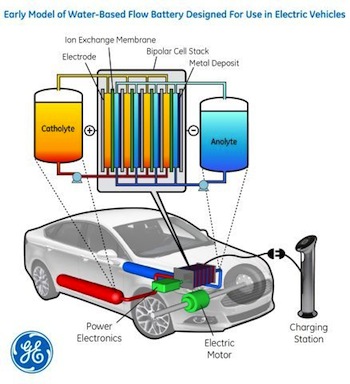Extending the range of electric vehicle (EV) batteries beyond the limits of short day trips is crucial for driving mainstream adoption.
Although Tesla’s Model S sedan can make it 265 miles before recharging, the upper per-charge thresholds tend to top out between 80 to 100 miles.
To address this, the Department of Energy (DOE) is funding research and development projects that could boost ranges up to 240 miles per charge. Last month, it awarded $36 million across 15 states for transformational EV energy storage systems through its Robust Affordable Next Generation EV-Storage (RANGE) program, administered by the Advanced Research Projects Agency Energy (ARPA-E).
One initiative backed by a $899,958 RANGE grant teams scientists from General Electric (GE) and Lawrence Berkeley National Lab, who are working on a water-based flow design that potentially improves both the capacity and safety of batteries.
"We’re excited about the impact this new technology could have on electric vehicles, especially as it relates to cost and the need to recharge," says Grigorii Soloveichik, project leader at GE Global Research and director of the GE-led Energy Frontier Research Center. "Our flow battery could be just one-fourth the price of car batteries on the market today, while enabling roughly three-times the current driving range. The DOE wants a battery that can power a car for 240 miles; we think we can exceed that."
Besides offering significant advantages in terms of cost and range, the flow battery could be easily integrated into current car designs; both stated goals of ARPA-E’s RANGE program, says GE. The team hopes to develop a working prototype within a year.
The flow battery derives its power from a novel electro-chemical reaction that all resides safely in a bath of water. Water-based solutions of inorganic chemicals can transfer more than one electron, providing high-energy density.
Flow batteries are generally lower in energy density, so they traditionally aren’t used in transportation applications.
Discharge and re-charge of such flow batteries occur in electrochemical cells separated from energy storing tanks, which makes them safer.
The graphic below illustrates their concept:

Two other projects funded by the ARPA-E grants also focus on flow batteries. The Illinois Institute of Technology is using $3.4 million for research that uses a high-density liquid as the electrode; and the National Renewable Energy Lab is putting $999,088 toward a design that employs organic energy storage materials.
DOE’s ARPA-E program has $120 million for its Batteries and Energy Storage Hub launched last year, to "develop radically new scientific approaches." The goal is to develop technology that provides five times the energy storage achievable today at 20% of the price by 2017.
Read about the other grantee projects:

I am curious about cold weather/climate implications, i.e. freezing.